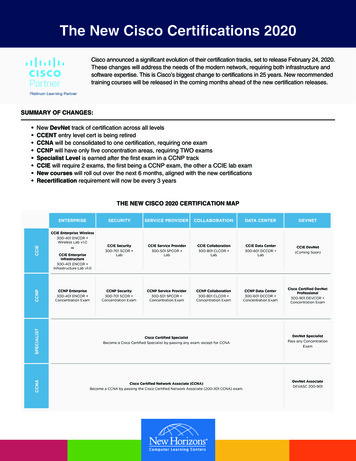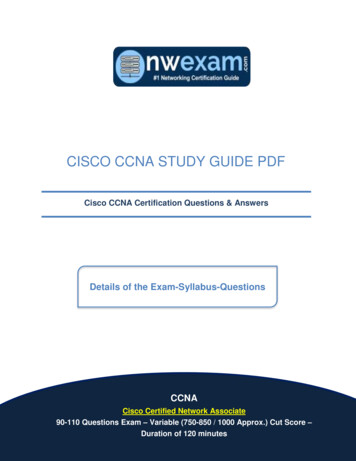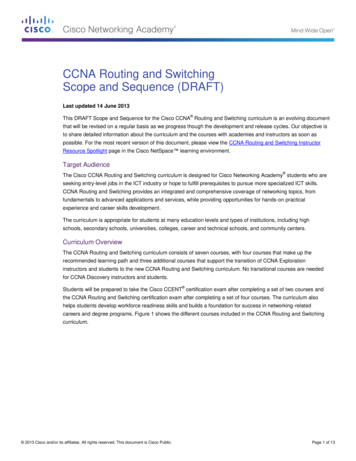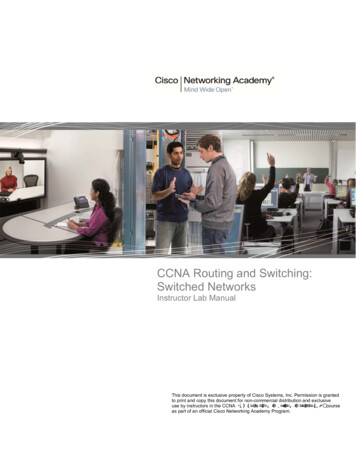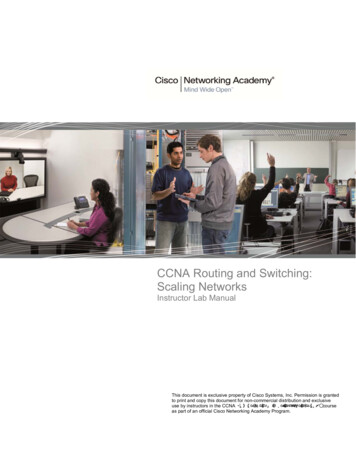
Transcription
Ccna routing and switching lab manual pdf free download
Sign Up to our social questions and Answers Engine to ask questions, answer people’s questions, and connect with other people. Have an account? Sign In Turn your PDF publications into a flip-book with our unique Google optimized e-Paper software. Copy PDF Download CCNA Routing and Switching Step By Step Lab Exercises CCNA 200-125 SelfStudy Lab Manual Extended embed settings Full PDF PackageDownload Full PDF PackageThis PaperA short summary of this paper7 Full PDFs related to this paperDownloadPDF Pack Full PDF PackageDownload Full PDF PackageThis PaperA short summary of this paper4 Full PDFs related to this paperDownloadPDF Pack Full PDF PackageDownloadFull PDF PackageThis PaperA short summary of this paper8 Full PDFs related to this paperDownloadPDF Pack 11/13/2017 CCNA Routing & Switching Lab Workbook Free CCNA Workbook Home About Blog Boot Camp Workbooks Stub Lab CCNA Routing & Switching Website Sponsor Section 1 – Getting Started with your Cisco Lab Lab 1-1 Lab 1-2Lab 1-3 Lab 1-4 Lab 1-5 Lab 1-6 Lab 1-7 Lab 1-8 Identifying Router Components and Accessories Connecting to a Cisco Router or Switch via Console Identifying Router & Switch IOS Software Configuring a Cisco Access Server Installing Graphical Network Simulator v3 Basic Graphic Network Simulator v3 Configuration Configuring TheFreeCCNAWorkbook GNS3 Topology Configuring a GNS3 Ethernet NIO Cloud Section 2 – Basic Cisco Router and Switch Management Lab 2-1 Lab 2-2 Lab 2-3 Lab 2-4 Lab 2-5 Lab 2-6 Lab 2-7 Lab 2-8 Lab 2-9 Lab 2-10 Lab 2-11 Lab 2-12 Lab 2-13 Lab 2-14 Cisco 2500 Series Router Password Reset Cisco 2600 Series Router Password Reset FixedConfiguration Catalyst Switch Password Reset Cisco Device Initial Configuration Dialog Navigating the Cisco Command Line Interface Configuring an IP address on an Interface Interface Specific Configurations Configuring a Loopback Interface Upgrading the Cisco Internetwork Operating System Recovering a Corrupt Cisco IOS Image on a 2500Series Router Recovering a Corrupt Cisco IOS Image on a 2600 Series Router Recovering a Corrupt Cisco IOS Image on a Catalyst Switch Configuring the Login, EXEC and MOTD Banners Reset Cisco IOS Configuration Specific Defaults Section 3 – Configuring Basic Cisco Device Security Lab 3-1 Lab 3-2 Lab 3-3 Lab 3-4 Lab 3-5 Lab 3-6 Lab 3-7 Lab3-8 Lab 3-9 Lab 3-10 Lab 3-11 Lab 3-12 Configuring Basic Password Authentication Configuring Local User Database Authentication Configuring AAA Authentication Lists Configuring AAA Authentication via TACACS Server Configuring Secure Shell Virtual Terminal Access (SSH) Configuring Numbered Access Control Lists Configuring NamedAccess Control Lists Configuring the VTY Line(s) Access Control List Configuring the Password Encryption Service Configuring an exec timeout and Login Failure Rate Configuring Cisco IOS Web Server Authentication Configure logging to a Remote SYSLog Server Search in blog Friends of Free CCNA Workbook Junos Workbook Free Juniper JNCIALabs Section 4 – Configuring Cisco Catalyst Series Switches Lab 4-1 Lab 4-2 Lab 4-3 Lab 4-4 Lab 4-5 Lab 4-6 Lab 4-7 Lab 4-8 Lab 4-9 Configuring Cisco Discovery Protocol (CDP) Creating Virtual Local Area Networks (VLAN’s) Configuring a Management VLAN Interface Configuring Trunk Ports using ISL or 802.1q Configuring An EtherChannel LinkConfiguring EtherChannel Utilizing PAgP Configuring EtherChannel Utilizing LACP Configuring a Port Channel Interface Configuring a Static ARP Entry Error 667 Subscribe Fans Followers RSS Feed 1/3 11/13/2017 Lab 4-10 Lab 4-11 Lab 4-12 Lab 4-13 Lab 4-14 Lab 4-15 Lab 4-16 Lab 4-17 Lab 4-18 Lab 4-19 Lab 4-20 Lab 4-21 CCNA Routing &Switching Lab Workbook Free CCNA Workbook Configuring VLAN Trunking Protocol (VTP) Configuring VTP Transparent Mode and VTP Pruning Configuring Inter-VLAN Routing (Router-on-a-Stick) Configuring Per-VLAN Spanning Tree Protocol Configuring Rapid Per-VLAN Spanning Tree Protocol Configuring Multiple Spanning Tree Protocol(MSTP) Configuring Switchport Spanning Tree Portfast Configuring Switchport Spanning Tree BPDU Guard Configuring STP Interface Specific Attributes Configuring Dynamic Switchport Security Configuring Sticky Switchport Security Configuring a Switched Port Analyzer Session Section 5 – Configuring Wide Area Network Links Lab 5-1 Lab 5-2Lab 5-3 Lab 5-4 Lab 5-5 Configuring Point-to-Point T1 Links using PPP or HDLC Configuring Point-to-Point Frame Relay Links Configuring Point-to-Point Frame Relay Sub-Interfaces Configuring a Point-to-Multipoint Frame Relay WAN Configuring and Understanding Frame Relay Inverse ARP Section 6 – Configuring Static Routing Lab 6-1 Lab 6-2 Lab6-3 Configuring Static Routing Configuring a Floating Static Route Configuring a Static Default Route Section 7 – Configuring Routing Information Protocol (RIP) Lab 7-1 Lab 7-2 Lab 7-3 Lab 7-4 Lab 7-5 Lab 7-6 Lab 7-7 Lab 7-8 Lab 7-9 Configuring Routing Information Protocol (RIP) Configuring RIP Versions 1 and 2 Configuring RIP TimersConfiguring RIP Triggered Updates Configuring RIP Interface Options Configuring RIP Static Neighbors Configuring RIP Default Information Originate Configuring RIP Route Summarization Configuring RIP Route Metric Offset-Lists Section 8 – Configuring Enhanced Interior Gateway Routing Protocol (EIGRP) Lab 8-1 Lab 8-2 Lab 8-3 Lab 8-4 Lab 8-5Lab 8-6 Lab 8-7 Lab 8-8 Lab 8-9 Configuring Basic EIGRP Configuring EIGRP Static Neighbors Configuring EIGRP Split Horizon Configuring EIGRP Stub Area Networks Configuring EIGRP Timers Configuring EIGRP Maximum Paths Configuring EIGRP Passive Interface Configuring EIGRP Route Summarization Configuring EIGRP Default RoutePropagation Section 9 – Configuring Open Shortest Path First (OSPF) Lab 9-1 Lab 9-2 Lab 9-3 Lab 9-4 Lab 9-5 Lab 9-6 Lab 9-7 Lab 9-8 Lab 9-9 Lab 9-10 Lab 9-11 Lab 9-12 Lab 9-13 Lab 9-14 Lab 9-15 Configuring Basic OSPF Configuring OSPF Priority Configuring OSPF Network Types Configuring OSPF Static Neighbors Configuring Multi-Area OSPFConfiguring The OSPF Router-ID Configuring OSPF Timers Configuring Per Interface OSPF Configuring OSPF Stub Areas Configuring OSPF Interface Cost Configuring OSPF Auto Cost Reference Bandwidth Configuring OSPF Passive Interface Configuring OSPF Maximum Paths Configuring OSPF Route Summarization Configuring OSPF DefaultRoute Propagation Section 10 – Configuring Route Redistribution Lab 10-1 Configuring Static Route Redistribution 2/3 11/13/2017 CCNA Routing & Switching Lab Workbook Free CCNA Workbook Lab 10-2 Lab 10-3 Lab 10-4 Configuring Mutual OSPF and RIP Redistribution Configuring Mutual OSPF and EIGRP Redistribution Configuring MutualEIGRP and RIP Redistribution Section 11 – Configuring IP Services Lab 11-1 Lab 11-2 Lab 11-3 Lab 11-4 Lab 11-5 Lab 11-6 Lab 11-7 Lab 11-8 Lab 11-9 Configuring Network Address Translation (NAT) One-to-One Configuring a Network Address Translation (NAT) Pool Configuring Port Address Translation (PAT) Many-to-One Configuring the CiscoIOS DHCP Server Configuring an IOS DHCP Server IP Exclusion Range Configuring an IP DHCP Helper Address Configuring the Cisco IOS NTP Client Configuring the Cisco IOS NTP Server Configuring Cisco IOS DNS Name Servers Section 12 – Configuring IP Version 6 (IPv6) Lab 12-1 Lab 12-2 Lab 12-3 Lab 12-4 Lab 12-5 Lab 12-6 The Basics ofInternet Protocol Version 6 (IPv6) Configuring IPv6 Interface Addressing Configuring IPv6 Static Routing Configuring Basic IPv6 RIPng Configuring Basic IPv6 OSPFv3 Configuring IPv6 Access List Section 13 – Installing and Configuring Cisco GUI’s Lab 13-1 Lab 13-2 Configuring SDM Minimum Requirements Installing Cisco Security DeviceManager (SDM) CCNA Challenge Labs Lab 1 Lab 2 CCNA Routing & Switching Challenge Lab 1 CCNA Routing & Switching Challenge Lab 2 (Coming Soon!) CCNA Pratice Exam(s) Exam 1 CCNA Practice Exam #1 (72 Questions) About Free CCNA Workbook Latest Tweets In 2008 Free CCNA Workbook originally started as a 2 years ago The@fccnawb website is not only sharable PDF but quickly evolved into the largest available in HTTPS. We've done this of course to CCNA training lab website on the net! make Google happy lol. The website was founded in late 2009 with the goal 2 years ago Interested in following the Founder Useful Links Stub Lab GNS3 Topology File Download GNS3- Cisco Device Emulator Download Geek Fluent Blog by Dave Henry of providing FREE Cisco CCNA labs that can be completed using the GNS3 platform. of the Free CCNA Workbook website? Check out @MattGeorgeCCIE Junos Workbook Free Juniper JNCIA Training Putty Terminal Emulator (Free Download) Quiz Me! - CCNA R&S Practice Exam Copyright 2009-2017 Free CCNA Workbook All Rights Reserved. Legal Privacy Policy Sitemap Contact Us 3/3 Instructor Note: Red font color or Gray highlights indicate text that appears in the instructor copy only.Describe the role of unicast, broadcast, and multicast in a switched network.Students are given three scenarios where activitybased numbers will need to be recorded. At the end of the activity, students will answer questions about how this introductory process relates to sending and receiving messages on a switch.When you arrived to class today, you were given a number by your instructor to use for this introductory class activity.Once class begins, your instructor will askcertain students with specific numbers to stand. Your job is to record the standing students' numbers for each scenario.Students with numbers starting with the number 5 should stand. Record the numbers of the standing students. All students will stand and all the numbers will be recorded by each student.Students with numbers ending in B shouldstand. Record the numbers of the standing students. More than one student should stand, but not all students will stand. All numbers of standing students will be recorded by all students.Students with the number 504C should stand. Record the number of the standing student. Only one student will stand and all students will record that number.Atthe end of this activity, divide into small groups and record answers to the Reflection questions on the PDF for this activity. S1(config)# %LINEPROTO-5-UPDOWN: Line protocol on Interface Vlan1, changed state to down %LINEPROTO-5-UPDOWN: Line protocol on Interface Vlan99, changed state to upTo establish connectivity between the host andthe switch, the ports used by the host must be in the same VLAN as the switch. Notice in the above output that the VLAN 1 interface goes down because none of the ports are assigned to VLAN 1. After a few seconds, VLAN 99 comes up because at least one active port (F0/6 with PC-A attached) is now assigned to VLAN 99.l. Issue show vlan briefcommand to verify that all the user ports are in VLAN 99. m. Configure the IP default gateway for S1. If no default gateway is set, the switch cannot be managed from a remote network that is more than one router away. It does respond to pings from a remote network. Although this activity does not include an external IP gateway, assume that youwill eventually connect the LAN to a router for external access. Assuming that the LAN interface on the router is 192.168.1.1, set the default gateway for the switch. S1(config)# ip default-gateway 192.168.1.1 S1(config)# n. Console port access should also be restricted. The default configuration is to allow all console connections with no passwordneeded. To prevent console messages from interrupting commands, use the logging synchronous option. S1(config)# line con 0 S1(config-line)# password cisco S1(config-line)# login S1(config-line)# logging synchronous S1(config-line)# exit S1 It is quite common to lock down access and install good security features on PCs and servers. It isimportant that your network infrastructure devices, such as switches and routers, are also configured with security features.In this lab, you will follow some best practices for configuring security features on LAN switches. You will only allow SSH and secure HTTPS sessions. You will also configure and verify port security to lock out any device with aMAC address not recognized by the switch. What is the port status of F0/5?The status is Secure-up, which indicates that the port is secure, but the status and protocol are up.e. From R1 command prompt, ping PC-A to verify connectivity.R1# ping 172.16.99.3f. You will now violate security by changing the MAC address on the router interface. Enterinterface configuration mode for G0/1 and shut it down.R1# config t R1(config)# interface g0/1 R1(config-if)# shutdown g. Configure a new MAC address for the interface, using aaaa.bbbb.cccc as the address.h. If possible, have a console connection open on S1 at the same time that you do this step. You will see various messages displayed on theconsole connection to S1 indicating a security violation. Enable the G0/1 interface on R1.i. From R1 privilege EXEC mode, ping PC-A. Was the ping successful? Why or why not? No, the F0/5 port on S1 is shut down because of the security violation.j. On the switch,verify port security with the following commands shown below. no activation-character no exec transport preferred none transport input all transport output pad telnet rlogin lapb-ta mop udptn v120 ssh stopbits 1 line 67 no activation-character no exec transport preferred none transport input all transport output pad telnet rlogin lapb-ta mop udptnv120 ssh line vty 0 4 password 7 13061E01080344 login transport input all ! scheduler allocate 20000 1000 ! end Switch S1 S1#sh run Building configuration. Current configuration : 3762 bytes version 15.0 no service pad service timestamps debug datetime msec service timestamps log datetime msec service password-encryption ! hostname S1 !enable secret 4 06YFDUHH61wAE/kLkDq9BGho1QM5EnRtoyr8cHAUg.2 ! username admin privilege 15 secret 4 tnhtc92DXBhelxjYk8LWJrPV36S2i4ntXrpb4RFmfqY ! no ip domain-lookup ip domain-name CCNA-Lab.com ! crypto pki trustpoint TP-self-signed-2530358400 enrollment selfsigned subject-name cn heck none rsakeypair TP-self-signed-2530358400 ! crypto pki certificate chain TP-self-signed-2530358400 Instructor Note: Red font color or Gray highlights indicate text that appears in the instructor copy only.Verify the Layer 2 configuration of a switch port connected to an end station.Students will use Packet Tracer to configure thefirst three ports of a switch a permanent MAC address (one MAC address per port) and security shutdown feature. They will validate security implementation and explain the process to another student or the class (Instructor choice).You are the network administrator for a small-to medium-sized business. Corporate headquarters for your business hasmandated that on all switches in all offices, security must be implemented. The memorandum delivered to you this morning states:"By Monday, April 18, 20xx, the first three ports of all configurable switches located in all offices must be secured with MAC addressesone address will be reserved for the PC, one address will be reserved for the laptop inthe office, and one address will be reserved for the office server.If a port's security is breached, we ask you to shut it down until the reason for the breach can be certified.Please implement this policy no later than the date stated in this memorandum. For questions, call Work with a partner in the class and create a Packet Tracer example to test thisnew security policy. Once you have created your file, test it with, at least, one device to ensure it is operational or validated.Save your work and be prepared to share it with the entire class. (Instructor choice) Reflection 1. Why would one port on a switch be secured on a switch using these scenario parameters (and not all the ports on the sameswitch)? Answers will varystudents may mention that securing every port on a switch would make it difficult for many users to connect to the switch, therefore limiting port use to certain pieces of equipmentlaptop mobility might be compromised, as users would notbe able to connect to the switch unless they knew which port they were allowed to use.2. Why would a network administrator use a network simulator to create, configure, and validate a security plan, instead of using the small-to medium-sized business' actual, physical equipment?After configuring port security for the Printer, Server and Laptopalldevices are reporting to the switch on their correct ports.Switch# show port-security address Secure Mac Address After exchanging the original Printer with a new one, Fa0/1 shuts down on the switch. Switches can be secured by assigning MAC addresses to any and all portsmanually or configurationbased LAN switch ports can be shut down ifsecurity on the port is breached. Network administrators can implement best practice policies devised by management to ensure that networks are not compromised through security attacks.Instructor Note: Red font color or Gray highlights indicate text that appears in the instructor copy only.Addressing Modern switches use virtual local-areanetworks (VLANs) to improve network performance by separating large Layer 2 broadcast domains into smaller ones. VLANs can also be used as a security measure by controlling which hosts can communicate. In general, VLANs make it easier to design a network to support the goals of an organization.In Part 2, you will create student, faculty, andmanagement VLANs on both switches. You will then assign the VLANs to the appropriate interface. The show vlan command is used to verify your configuration settings.Step 1: Create VLANs on the switches.a. Create the VLANs on S1. S1(config)# vlan 10 S1(config-vlan)# name Student S1(config-vlan)# vlan 20 S1(config-vlan)# name FacultyS1(config-vlan)# vlan 99 S1(config-vlan)# name Management S1(config-vlan)# end b. Create the same VLANs on S2.c. Issue the show vlan command to view the list of VLANs on S1. Step 2: Assign VLANs to the correct switch interfaces.a. Assign VLANs to the interfaces on S1. 1) Assign PC-A to the Student VLAN. S1(config)# interface f0/6 S1(configif)# switchport mode access S1(config-if)# switchport access vlan 10 2) Move the switch IP address VLAN 99. S1(config)# interface vlan 1 S1(config-if)# no ip address S1(config-if)# interface vlan 99 S1(config-if)# ip address 192.168.1.11 255.255.255.0 S1(config-if)# end b. Issue the show vlan brief command and verify that the VLANs are assignedto the correct interfaces. g. Use the show vlan brief command to verify that the VLANs are assigned to the correct interfaces. No. Interface F0/1 is not assigned to VLAN 10, so VLAN 10 traffic will not be sent over it.Is S1 able to ping S2? Why?No. The IP addresses for the switches now reside in VLAN 99. VLAN 99 traffic will not be sent over interfaceF0/1.In Part 3, you will change VLAN assignments to ports and remove VLANs from the VLAN database.Step 1: Assign a VLAN to multiple interfaces.a. On S1, assign interfaces F0/11 -24 to VLAN 10. S1(config)# interface range f0/11-24 S1(config-if-range)# switchport mode access S1(config-if-range)# switchport access vlan 10 S1(config-if-range)#end b. Issue the show vlan brief command to verify VLAN assignments. S1(config)# interface range f0/11, f0/21 S1(config-if-range)# switchport access vlan 20 S1(config-if-range)# end d. Verify that VLAN assignments are correct. Step 2: Remove a VLAN assignment from an interface.a. Use the no switchport access vlan command to remove theVLAN 10 assignment to F0/24. S1(config)# interface f0/24 S1(config-if)# no switchport access vlan S1(config-if)# end b. Verify that the VLAN change was made.Which VLAN is F0/24 is now associated with? VLAN 1, the default VLAN. Step 3: Remove a VLAN ID fromthe VLAN database.a. Add VLAN 30 to interface F0/24 without issuing the VLAN command. S1(config)# interface f0/24 S1(config-if)# switchport access vlan 30 % Access VLAN does not exist. Creating vlan 30Note: Current switch technology no longer requires that the vlan command be issued to add a VLAN to the database. By assigning an unknownVLAN to a port, the VLAN adds to the VLAN database.b. Verify that the new VLAN is displayed in the VLAN table. The interfaces assigned to a VLAN that is the removed from the VLAN database are unavailable for use until they are reassigned to another VLAN. This can be a tricky thing to troubleshoot as trunked interfaces do not show up in the portlist as well (Part 4 contains more information about trunked interfaces).In Part 4, you will configure interface F0/1 to use the Dynamic Trunking Protocol (DTP) to allow it to negotiate the trunk mode. After this has been accomplished and verified, you will disable DTP on interface F0/1 and manually configure it as a trunk.Step 1: Use DTP to initiatetrunking on F0/1.The default DTP mode of a 2960 switch port is dynamic auto. This allows the interface to convert the link to a trunk if the neighboring interface is set to trunk or dynamic desirable mode.a. Set F0/1 on S1 to negotiate trunk mode. S1(config)# interface f0/1 S1(config-if)# switchport mode dynamic desirable Port Vlans allowed andactive in management domain Fa0/ Port Vlans in spanning tree forwarding state and not pruned Fa0/ Note: By default, all VLANs are allowed on a trunk. The switchport trunk command allows you to control what VLANs have access to the trunk. For this lab, keep the default settings which allows all VLANs to traverse F0/1.Step 2: Manually configuretrunk interface F0/1.The switchport mode trunk command is used to manually configure a port as a trunk. This command should be issued on both ends of the link.a. Change the switchport mode on interface F0/1 to force trunking. Make sure to do this on both switches. S1(config)# interface f0/1 S1(config-if)# switchport mode trunk S2(config)#interface f0/1 S2(config-if)# switchport mode trunk b. Issue the show interfaces trunk command to view the trunk mode. Notice that the mode changed from desirable to on.Port Mode Encapsulation Status Native vlan Fa0/1 on 802.1q trunking 99Port Vlans allowed on trunk Fa0/1 Port Vlans allowed and active in management domain Fa0/ Port Vlansin spanning tree forwarding state and not pruned Fa0/ Why might you want to manually configure an interface to trunk mode instead of using DTP? Not all equipment uses DTP. Usingthe switchport mode trunk command ensures that the port will become a trunk no matter what type of equipment is connected to the other end of the link.In Part 5, you will delete the VLAN Database from the switch. It is necessary to do this when initializing a switch back to its default settings. Step 2: Delete the VLAN database.a. Issue the deletevlan.dat command to delete the vlan.dat file from flash and reset the VLAN database back to its default settings. You will be prompted twice to confirm that you want to delete the vlan.dat file. Press Enter both times. To get a switch back to its default settings, the erase startup-config and reload commands need to be issued after the delete vlan.datcommand.1. What is needed to allow hosts on VLAN 10 to communicate to hosts on VLAN 20? Answers will vary, but Layer 3 routing is needed to route traffic between VLANs.2.What are some primary benefits that an organization can receive through effective use of VLANs?Answers will vary, but VLAN benefits include: better security, cost savings (efficient use of bandwidth and uplinks), higher performance (smaller broadcast domains), broadcaststorm mitigation, improved IT staff efficiency, simpler project and application management.Switch S1Building configuration. Instructor Note: Red font color or Gray highlights indicate text that appears in the instructor copy only.Addressing Interface name Guest interface range f0/1-24 switchport mode access shutdown !interface f0/1 !switchportmode trunk !no shutdown interface range f0/7-12 !interface range f0/6-12 switchport access vlan 10 interface range f0/13-18 switchport access vlan 2 !switchport access vlan 20 interface range f0/19-24 switchport access vlan 30 end Switch S2 Configuration:hostname S2 vlan 10 Name Students vlan 20 Name Faculty vlan 30 Name Guest interfacef0/1 switchport mode trunk switchport trunk allowed vlan 1,10,2,30 !switchport trunk allowed vlan 1,10,20,30 interface range f0/2-24 switchport mode access shutdown !interface range f0/6-12 !switchport access vlan 10 interface range f0/13-18 switchport access vlan 20 interface range f0/19-24 switchport access vlan 30 shutdown endStep 6: Copythe running configuration to the startup configuration.In Part 2, you must examine VLAN 10 on S1 and S2 to determine if it is configured correctly. You will troubleshoot the scenario until connectivity is established.Step 1: Troubleshoot VLAN 10 on S1.a. Can PC-A ping PC-B? No b. After verifying that PC-A was configured correctly,examine the S1 switch to find possible configuration errors by viewing a summary of the VLAN information. Enter the show vlan brief command. Yes. The port for PC-A is not assigned to the correct VLAN. The port for F0/1 is assigned to VLAN 1; therefore, it is not acting as a trunk port.d. Examine the switch for trunk configurations using the showinterfaces trunk and the show interface f0/1 switchport commands.e. Are there any problems with the trunking configuration? Yes. No trunk ports exist and F0/1 is configured as an access port instead of a trunk port.f. Examine the running configuration of the switch tofind possible configuration errors.Are there any problems with the current configuration? Yes. F0/1-5 are all configured as access ports and all ports on the switch are shutdown.g. Correct the errors found regarding F0/1 and VLAN 10 on S1. Record the commands usedin the space below.S1(config)# interface f0/1 S1(config-if)# no shutdown S1(config-if)# switchport mode trunk S1(config-if)# interface f0/6 S1(config-if)# no shutdown S1(config-if)# switchport access vlan 10 h. Verify the commands had the desired effects by issuing the appropriate show commands. Step 2: Troubleshoot VLAN 10 on S2.a. Using the previouscommands, examine the S2 switch to find possible configuration errors.Are there any problems with the current configuration? Yes. No ports were assigned access to VLAN 10 and ports f0/1 and f0/11 are shutdown. In Part 3, you must examine VLAN 20 on S1 and S2to determine if it is configured correctly. To verify functionality, you will reassign PC-A into VLAN 20, and then troubleshoot the scenario until connectivity is established.Step 1: Assign PC-A to VLAN 20. b. On S1, assign the port for PC-A to VLAN 20. Write the commands needed to complete theconfiguration. S1(config)# interface f0/6 S1(config-if)# switchport access vlan 20 c. Verify that the port for PC-A has been assigned to VLAN 20. Step 2: Troubleshoot VLAN 20 on S1.a.Using the previous commands, examine the S1 switch to find possible configuration errors.Are there any problems with the current configuration? Yes. VLAN 2 was created instead ofVLAN 20 and ports have been assigned to VLAN 2 instead of VLAN 20.b. Correct the errors found regarding VLAN 20. S1(config)# interface range f0/13-18 S1(config-if-range)# switchport access vlan 20 S1(config-if-range)# exit S1(config)# no vlan 2 S1(config)# vlan 20 S1(config-vlan)# name FacultyStep 3: Troubleshoot VLAN 20 on S2.a. Using theprevious commands, examine the S2 switch to find possible configuration errors.Are there any problems with the current configuration? Yes. The trunked interface has been misconfigured to allow communication for VLAN 2 instead of VLAN 20 and port f0/18 isshutdown. 1. Why is a correctly configured trunk port critical in a multi-VLAN environment? An 802.1Q trunk port allows for transmission of multiple VLANs across one link. Anincorrectly configured trunk port can prevent VLANs from communicating across switches.2. Why would a network administrator limit traffic for specific VLANs on a trunk port?To prevent unwanted VLAN traffic from traveling through that trunk port.Instructor Note: The VLANs configured do not display in the running configuration but are stored in the vlan.dat file. Best practice dictates configuring some basic security settings for both access and trunk ports on switches. This will help guard against VLAN attacks andpossible sniffing of network traffic within the network. Step 6: Configure basic switch security.a. Configure a MOTD banner to warn users that unauthorized access is prohibited.b. Encrypt all passwords.c. Shut down all unused physical ports.d. Disable the basic web
Labs Section 4 - Configuring Cisco Catalyst Series Switches Lab 4-1 Lab 4-2 Lab 4-3 Lab 4-4 Lab 4-5 Lab 4-6 Lab 4-7 Lab 4-8 Lab 4-9 Configuring Cisco Discovery Protocol (CDP) Creating Virtual Local Area Networks (VLAN's) Configuring a Management VLAN Interface Configuring Trunk Ports using ISL or 802.1q Configuring An EtherChannel Link
